Koshari (The National Dish of Egypt)
This post may contain affiliate links. See my disclosure policy.
The national dish of Egypt, Koshari is a vegetarian dish that features rice, lentils, macaroni pasta, garbanzo beans, and crispy fried onions all tied together with a spicy tomato sauce. It’s Egyptian street food at its best and this authentic koshari recipe is one you’ll make again and again!
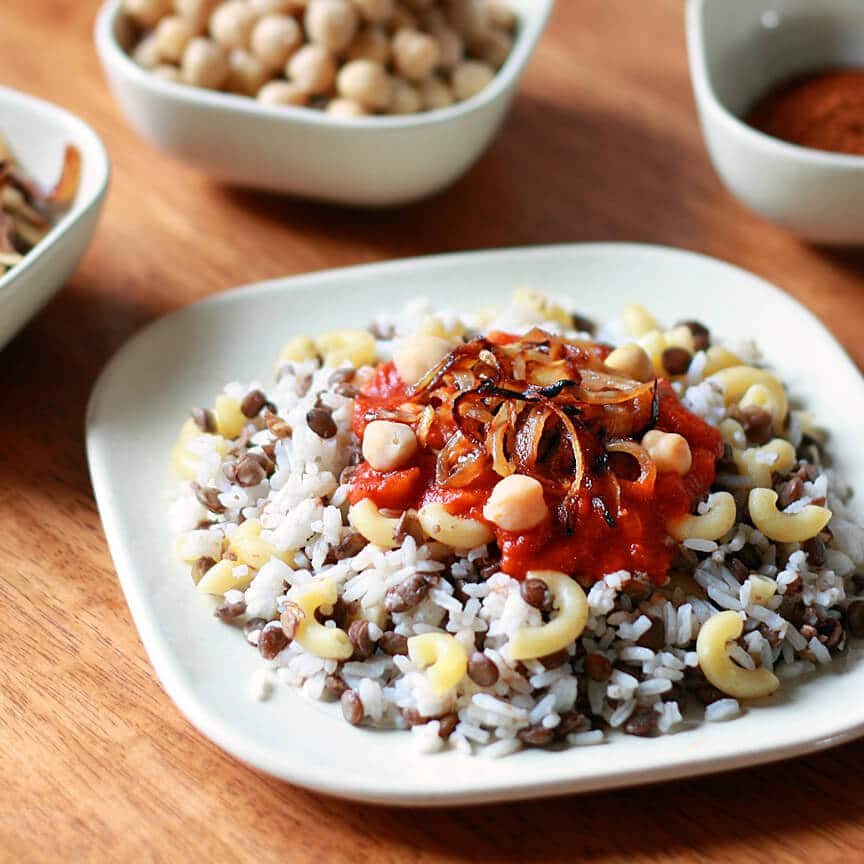
This koshari recipe is one of the very first recipes I published on my blog back in early 2013. Soon thereafter it was featured in magazines and across the web. It has remained a favorite in our home and I hope you’ll enjoy it as much as we do!
What is Koshari?
During my time as college student doing a study abroad in Jerusalem with trips Egypt, Jordan and Lebanon, I took advantage of the opportunity to delve into the local cuisines, to talk as best I could with local cooks and spice merchants, and enjoy every moment of it. When I was in Egypt one of the first dishes I sampled was koshari, served up hot by a street vendor. Koshari (also spelled Koshary or Kushari) is the national dish of Egypt and it’s served in virtually every Egyptian restaurant, in every Egyptian home, and on every Egyptian street corner. Street vendors serve the dish from carts to people eagerly waiting in line to eat this popular dish. An unusual combination, Koshari mixes lentils, macaroni noodles and rice into a single dish and it’s then topped with a spicy tomato sauce and the dotted with garbanzo beans and fried onions. It’s one of those dishes that may not sound terribly exciting from the description alone. But then you taste it. And then you understand why this dish is a favorite among Egyptians.
Egyptians and tourists fondly speak of the “Koshari Man,” the title bestowed upon street vendors who sell the dish from their carts. Aziz Awad, who used to be a Koshari street vendor and now works at a downtown restaurant, describes it this way: “The Koshari man grabs a bowl, and scoops a little of each ingredient into the bowl….Each Koshary dish takes about five seconds to [assemble]. His speed can be surprising to you. I have worked here since we opened 10 years ago, and before that I sold Koshary on a street cart, so I have to be fast. My hands are accustomed to the same movements I do all day everyday, so you can say that I memorized the movements rather than think about them” (source www.touregypt.net). I had the privilege of watching such a Koshari Man in action as he assembled my koshari and what seemed like the speed of light.
Every Egyptian knows and recognizes the sound of Koshari being made from down the street. Heba Fatteen Bizzari explains, “As the Koshari man scoops, he knocks his metal spoon against the sides of the bowls, making the Koshari symphony that you won’t hear elsewhere. When the Koshari man prepares an order of more than four the restaurant fills with sound as if it was a rehearsal for a concert. The restaurants of Koshari are very noisy. One sits to eat while the Koshari man practices his drums in your ears” (source www.touregypt.net).
Where Did Koshari Originate?
Interestingly, although it is Egypt’s national dish, it isn’t actually Egyptian in origin. Neither rice nor macaroni are indigenous to Egypt. It is believed that Koshari originated in India and dates back to the time of British Colonization. The name “Koshari” is actually from the Hindu “khichri”, which refers to a dish of lentils and rice (in fact India has a popular lentil and rice dish called kitchari). When the British arrived in Egypt in the late 1800’s they brought this dish with them – it was inexpensive and filling. It didn’t take long before the dish was enthusiastically embraced by the Egyptian people.

Key Ingredient: Baharat
The crowning aspect of this dish is the flavor-packed, spicy tomato sauce. It’s made with a special Middle Eastern spice blend called Baharat (Arabic for “spice”), an all-purpose spice blend commonly used in Middle Eastern cuisine. Just a pinch adds depth and flavor to sauces, soups, stews and meat. I stocked up on on a myriad of Middle Eastern spices when I was in the Middle East, studied them extensively when I got home, and have been making my own spice blends since. Yep, in the picture below that’s me in one of the many, many spice shops I visited throughout the Middle East as a study abroad college student.
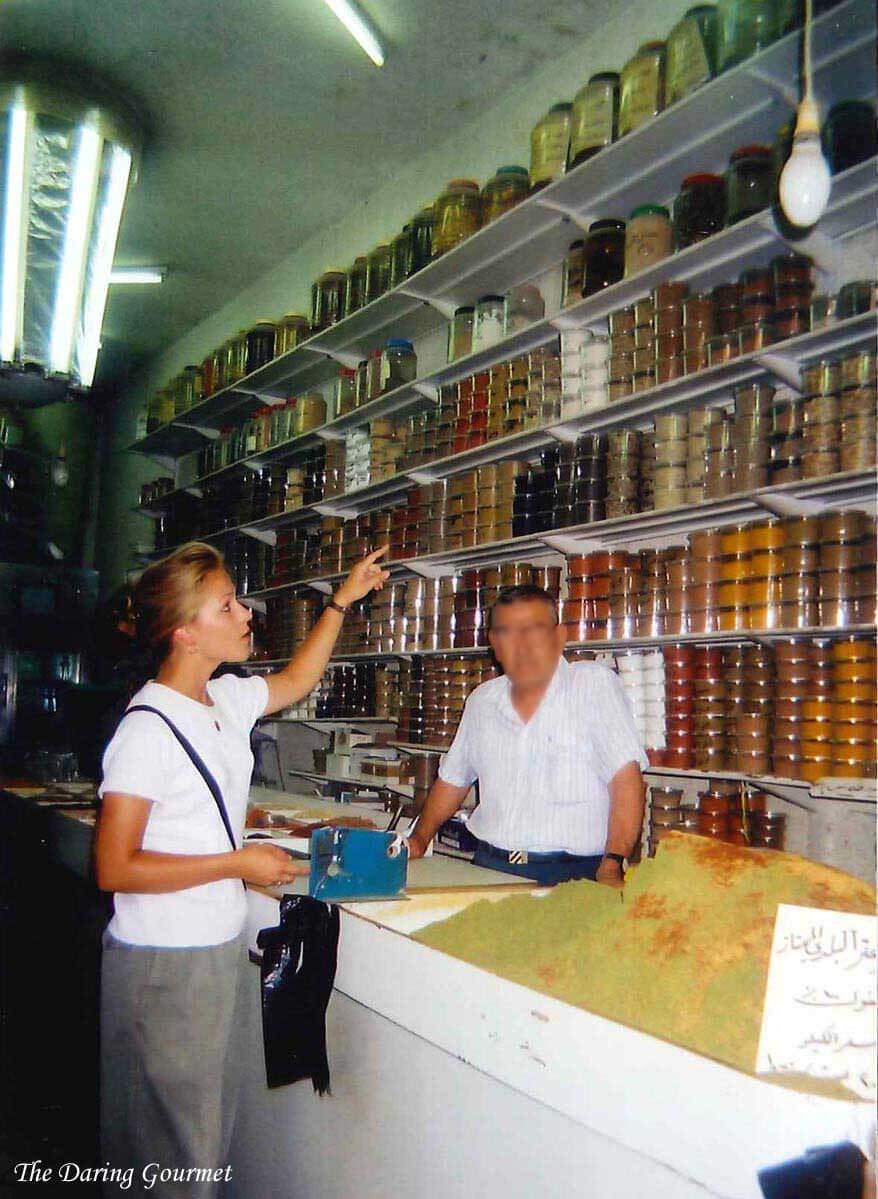
Unless you have a Middle Eastern store in your area or order it online, this spice blend can be challenging to find. However, as with any spice blend, it’s practically a hundred times better made fresh in your own kitchen anyway. The flavors are more robust and vibrant and homemade baharat will seriously transform your koshari.
Check out my homemade authentic Baharat recipe!
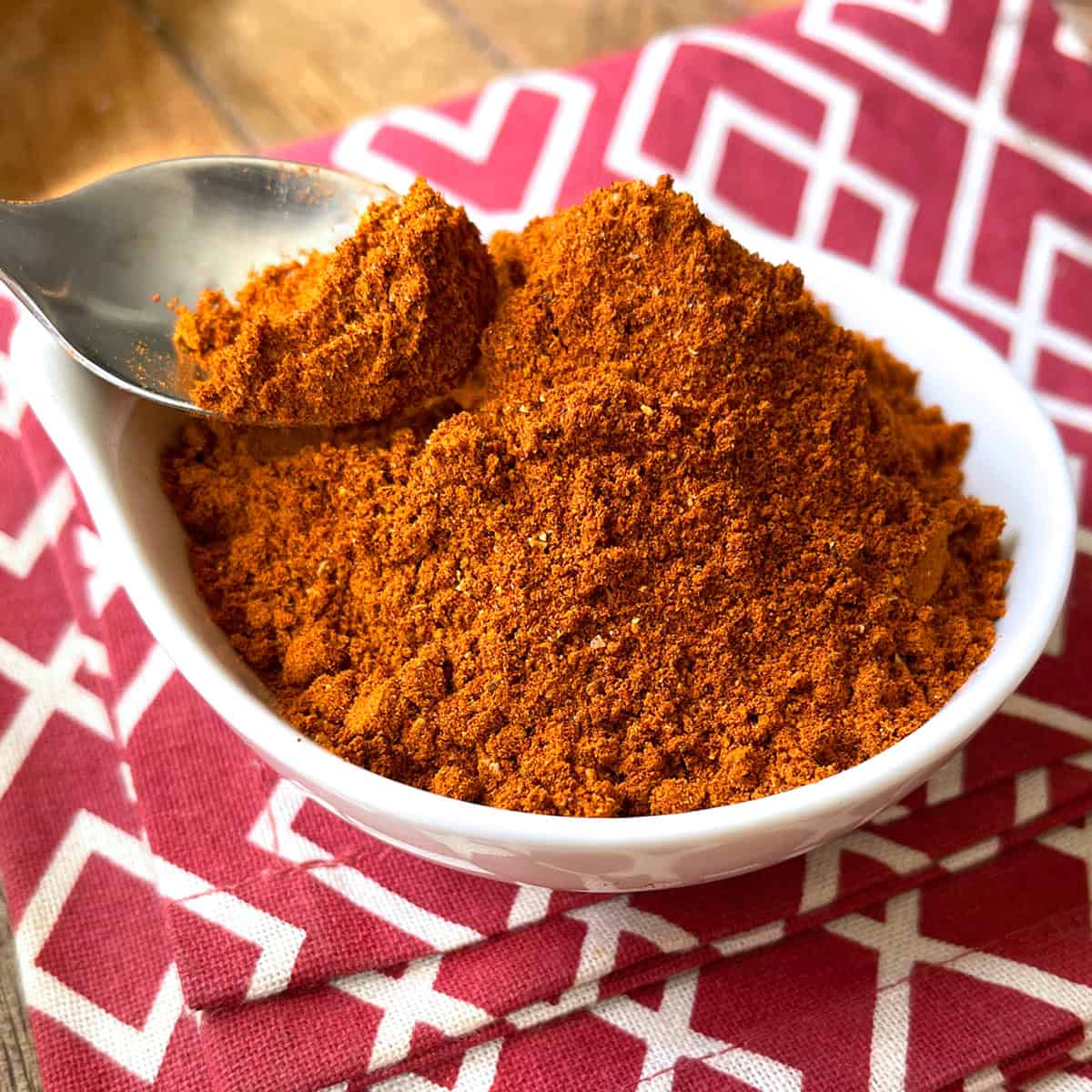
Koshari Recipe
This recipe is very authentic and simple to make, but be prepared to dirty up a few pots! Here’s how to make it:
- Make the Rice: Heat 2 tablespoons of olive oil in a medium saucepan over medium-high heat. Add the rice and fry it for 2 minutes, then add the vegetable stock. Bring it to a boil, decrease the heat to low, cover and simmer for 15 minutes or until the rice is cooked. Leave in the pot to keep warm and set aside.
- Make the Lentils: Rinse the lentils under cold water and add them to another medium saucepan with 2 cups of water. Add the garlic, cumin and bay leaf and bring it to a boil. Reduce the heat to low, cover and simmer for 20-30 minutes or until the lentils are tender. Once cooked, add the salt and stir to combine. Strain any excess liquid if necessary. Leave in the pot to keep warm and set aside.
- Make the Macaroni: Cook the macaroni according to package instructions until al dente. Leave in the pot to keep warm and set aside.
- Make the Sauce (do this while the rice, lentils and macaroni are cooking or it can also be made up to a day in advance): Heat the oil in a medium saucepan over medium-high heat and add the onion. Cook until soft and translucent, about 5-7 minutes. Add the garlic and saute until golden brown. Add the tomato sauce, baharat, salt and pepper to taste, chile flakes (if using) and red wine vinegar. Bring it to a simmer, reduce the heat to low, cover and simmer for 20 minutes, stirring occasionally.
- Make the Crispy Onions: Heat the oil in a skillet. Add the onions and fry until dark brown. Using a slotted spoon, remove them from the oil and place them on paper towels to drain and cool. Set aside.
- Assemble the Koshari: Add the rice, lentils and macaroni to a large bowl and toss to combine (or simply scoop out desired amounts of each onto the plates). Sprinkle a little baharat over each portion and serve topped with some of the spicy tomato sauce. Top with garbanzo beans, the crispy onions and another sprinkle of baharat. Serve warm.
Each of these components can be made up to a day in advance and then simply reheated and assembled. It’s the perfect make-ahead dish!
Enjoy!
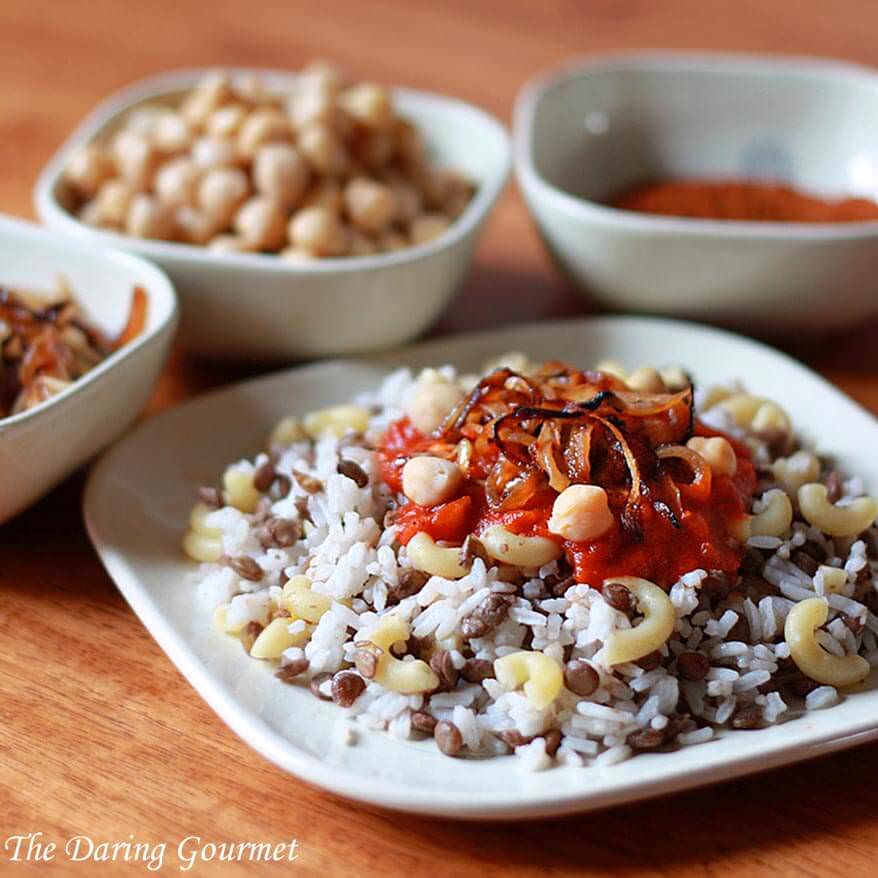
For more authentic Middle Eastern recipes be sure to try my:
- Harira
- Falafel
- Za’atar
- Chicken Machboos
- Lavash
- Dukkah
- Djej Makalli
- Kusksu
- Hummus
- Moroccan Chicken Tagine
- Preserved Lemons
- Baba Ganoush
- Tahini
Save This Recipe
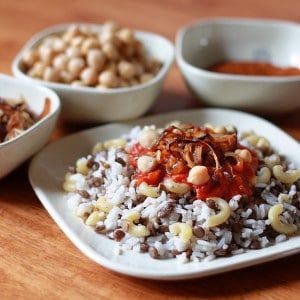
Koshari (The National Dish of Egypt)
Ingredients
- 2 tbs olive oil
- 1 cup medium grain rice
- 1 cup brown lentils
- 2 cups small uncooked macaroni noodles (Gluten Free: use GF pasta)
- 2 cups vegetable broth
- 1 garlic clove , quartered
- 1 teaspoon cumin
- 1 bay leaf
- 1/2 teaspoon salt
- Salt to taste
- For the Sauce:
- 2 tablespoon olive oil
- 1 small onion , diced finely
- 2 cloves garlic , finely minced
- 1 15 ounce can plain tomato sauce
- 2-3 teaspoons baharat spice blend
- Homemade Baharat , click link for recipe (strongly recommended for the best flavor!)
- 1/4 teaspoon red chile flakes (omit if you don't like it spicy hot)
- 1 tablespoon red wine vinegar
- Salt & pepper to taste
- Crispy Onion Garnish:
- 2 large onions , very finely sliced
- Oil for deep-frying
- 1 15 ounce can garbanzo beans , rinsed and drained
Instructions
- Make the Rice: Heat 2 tablespoons of olive oil in a medium saucepan over medium-high heat. Add the rice and fry it for 2 minutes, then add the vegetable stock. Bring it to a boil, decrease the heat to low, cover and simmer for 15 minutes or until the rice is cooked.Make the Lentils: Rinse the lentils under cold water and add them to another medium saucepan with 2 cups of water. Add the garlic, cumin and bay leaf and bring it to a boil. Reduce the heat to low, cover and simmer for 20-30 minutes or until the lentils are tender. Once cooked, add the salt and stir to combine. Strain any excess liquid if necessary.Make the Macaroni: Cook the macaroni according to package instructions until al dente.Leave each of these in the pot to keep warm and set aside.
- Make the Crispy Onions: Heat the oil in a skillet. Add the onions and fry until dark brown. Using a slotted spoon, remove them from the oil and place them on paper towels to drain and cool.
- Make the Sauce: Heat the oil in a medium saucepan over medium-high heat and add the onion. Cook until soft and translucent, about 5-7 minutes. Add the garlic and saute until golden brown. Add the tomato sauce, baharat, salt and pepper to taste, chile flakes (if using) and red wine vinegar. Bring it to a simmer, reduce the heat to low, cover and simmer for 20 minutes, stirring occasionally.
- Assemble the Koshari: Add the rice, lentils and macaroni to a large bowl and toss to combine (or simply scoop out desired amounts of each onto the plates). Sprinkle a little baharat over each portion and serve topped with some of the spicy tomato sauce. Top with garbanzo beans, the crispy onions and another sprinkle of baharat. Serve warm.Note: Each of the components can be made well in advance and then simply reheated and assembled.
Nutrition
Originally published on The Daring Gourmet February 21, 2013



















Dumb question… is that two cups of cooked macaroni or uncooked? I assume uncooked but that seems like a lot relative to the amount of rice.
Hi Don! Yes, it’s 2 cups of uncooked macaroni. Happy cooking!
Koshari is great – and very healthy! High fiber, high protein, vegan, and if you measure your ingredients carefully (and omit the crispy onions), about 425 calories will fill you up. Thanks for getting this recipe out there!
So true, Matthew! But I couldn’t live without those crispy onions!! If it means an extra 10 minutes on the treadmill, SO worth it! :)
There are 3 instances of onion called for in your ingredients (once in the main bunch, once with the sauce, and once with the crispy onions), but they are only in the instructions for the sauce and crispy onions bits. The “2 large onions, thinly sliced” are unaccounted for.
Hi Emily, thanks for pointing that out! The “2 large onions, thinly sliced” are for the crispy onions portion only.
有机会的话,很想品尝下!!!
Google Translation: “There is a chance, would like to taste the next! ! !”
Excellent, happy cooking and enjoy!
Ah how wonderful! I remember eating a lot of Koshary when I stayed in Cairo. I also remember just how huge the portions always were for such a filling dish. Will have to try making my own sometime with this delicious recipe :)
It’s true the portions are very generous in that region of the world. Very different than, for example, France where you leave the restaurant still starving! :) Thanks for visiting, Natalie, and enjoy the Koshari!
i tried your recipe and believe me it was fantastic…thanks for such an authentic recipe…i had kushari in saudi arabia and then in dubai and now i m in toronto and was craving for it and it really satisfied my taste buds…thanks once again:)
Ah, that’s so wonderful to hear, Jazz! I work very hard to create the most authentic recipes possible and I’m always so thrilled to receive feedback like yours from people who are familiar with “the real thing.” Thanks so much for taking the time to let me know what you thought! Best, Kimberly
what a great recipe – just waiting for the rice to finish cook and then I will be enjoying it for my lunch – I cook all types of global food and so glad to learn about this new recipe..thx
Thank you, Chef Mireille! So glad you’re making this and thank you for stopping by!
As an Egyptian I would love to say that you’ve done a wonderful job. The dish looks absolutely gorgeous! Can I please use this picture in Egypt’s Wikipedia page in the “Cuisine” section? It will be a fantastic addition to the page.
Thank you very much for the compliment, Yasser! I really appreciate that.
As to the Wikipedia matter, as much as I’d like to say yes, I unfortunately have to say no. The reason being, any pictures submitted to Wikipedia become public domain and can be used by anyone at any time for anything (including commercial use) – without restriction. Still, I greatly appreciate your compliment and I thank you for visiting.